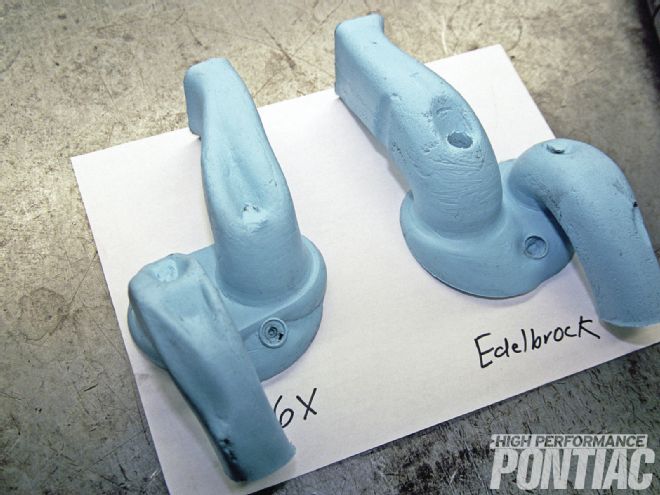
If one were to dissect the Pontiac enthusiast community, the disciples of the brand can be put into a few different groups. For example, some find favor with a perfectly restored numbers-matching Pontiac while others are desirous of an all out race car—and there are many tastes that come in between those extremes. A gamut that wide makes HPP an interesting magazine, since it needs to cover all aspects of Pontiac ownership.
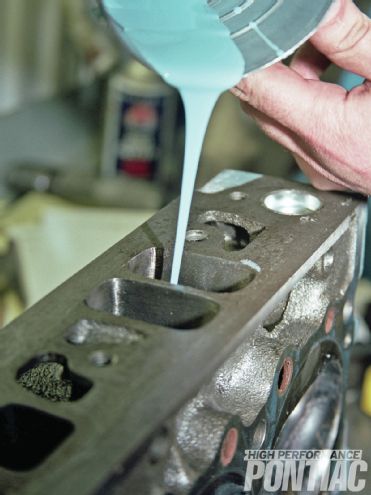
A Clear Picture
Every internal combustion engine can be considered nothing more than an air pump. The more air that can be packed into the cylinders with the proper mix of fuel, the more power the engine has the potential to make. Undeniably, the cylinder head is the key component in the recipe for horsepower.
When examining the cylinder head, the combustion chamber shape and size, along with the intake and exhaust port configuration, are key factors. Other areas are important, such as the valve size and angle in relation to the bore center and the spark plug location, again referenced from the center of the cylinder. For all intents and purposes, the enthusiast can only modify the port shape, while the other factors are design elements.
Porting of the cylinder head is the key to optimizing airflow for that casting, and as with most things, can be done to the level you desire—you can do as much or as little as you want with a corresponding gain in power. The key to porting a cylinder head is to remove or re-contour the material where it will improve airflow and port velocity. The speed of the incoming charge (air and fuel mixed together) is paramount in achieving a high level of cylinder fill that is identified as volumetric efficiency. An individual who goes in a port and just starts grinding is akin to being blindfolded while shooting at a target. It is possible to hit it but the probability is very low.
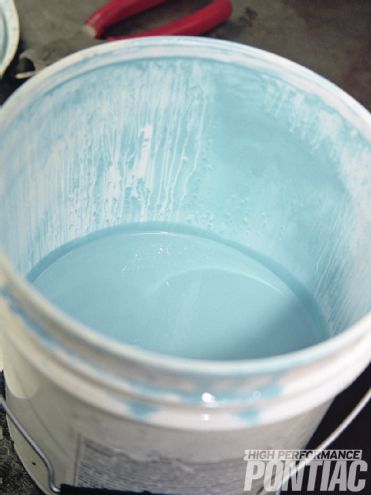 1 Blu-Sil comes in two separate tubs, and when mixed together, has the appearance of a thick paint.
1 Blu-Sil comes in two separate tubs, and when mixed together, has the appearance of a thick paint.
Within the industry it has been determined that the valve angles and the bowl of the port (the area just above the valve seat on the runner side) pays the greatest dividends when looking to improve airflow. A production-style cylinder head probably does not exist that will not see a dramatic flow increase with a blended bowl and high-quality multi-angle valve job, which has the seat cut and not ground into shape (Note: Many in the Pontiac community have not embraced the benefit of using a cutting bit to form the seat angles in lieu of the traditional method of employing stones to grind the seat. For more on this, reference the April ’12 issue, “Project Pure Poncho: Porting and Machining the Cylinder Heads” or online at http://www.highperformancepontiac.com/tech/hppp_1204_porting_and_machining_cylinder_heads/. If you want more airflow after that, the runner and complete port will need to be worked.
A problem with reworking a port, even for the most experienced head porter, is that you cannot really see what is going on. Looking into the port from either side can show some of the area, but you are guessing at the true shape of the majority of the passage. The best method of attack then would be to have a sacrificial cylinder head that can be placed on a bandsaw and cut in half, exposing the intake and exhaust port. Now you can formulate a proper plan since the flow restrictions and obstacles are in clear view.
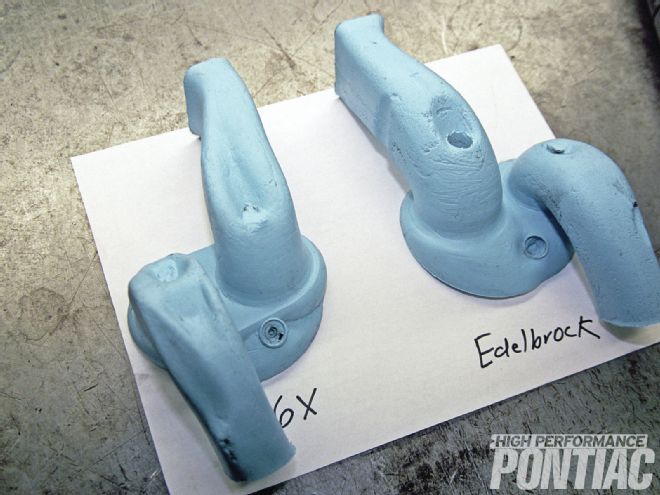 2 These are the complete molds of the already-ported 6X and the unported Edelbrock D-port cylinder heads. The taper in the intake runner of the 6X casting is clearly seen about 1 inch in from the entry. When you look in the casting, it is apparent, but you are not aware of how dramatic it is.
2 These are the complete molds of the already-ported 6X and the unported Edelbrock D-port cylinder heads. The taper in the intake runner of the 6X casting is clearly seen about 1 inch in from the entry. When you look in the casting, it is apparent, but you are not aware of how dramatic it is.
The reality being it is not practical—or in many cases, even possible—to have an extra cylinder head laying around to cut in half. Also, what if you want to compare ports before you make an investment, you cannot go around cutting everything in half—there has to be a better and more practical approach. Port molding is the answer.
Making An Image
Though there may be some debate as to when the practice of making a mold of the ports came about, Bob Wells of Perma-Flex Mold Company tells HPP that to the best of his recollection, the Chevrolet Division of General Motors first did this using the Perma-Flex molding rubber sometime in the ’60s. It seems that Perma-Flex was and still is a supplier to GM for a variety of molding and other materials. The engineers faced the same problem as the Pontiac enthusiast when wanting to examine a port. Thus, someone at GM came up with the idea of employing a method that was already used in other aspects of development for a variety of parts—they made a mold. The Perma-Flex Blu-Sil silicone rubber is the material of choice to make a mold of a Pontiac cylinder-head port or that of an intake manifold runner.
Blu-Sil is a two-part product that needs to be mixed just prior to pouring it into the port of the cylinder head. It retails for $163 plus shipping, and includes enough to make a mold that displaces the volume of one gallon—you can make many port molds with the basic investment. Please contact Perma-Flex Mold Company for exact specifications and mixing procedures for its product, along with a suggested release agent, such as petroleum jelly.
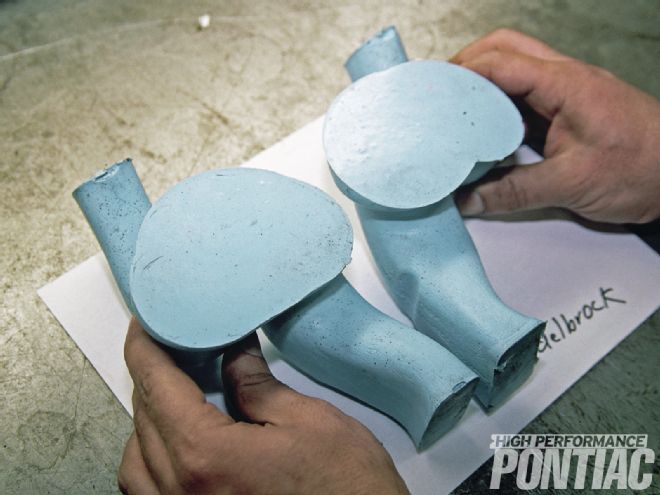 3 The combustion chamber shape of the two different cylinder head designs is apparent, along with the intake track.
3 The combustion chamber shape of the two different cylinder head designs is apparent, along with the intake track.
Deciding on what area of the port you want to study will determine the mold that you make. For this primer, HPP used The Mule’s well-modified 6X casting, along with the Edelbrock D-port cylinder head.
We chose to make the most intricate and difficult mold, one of the complete ports attached to the combustion chamber. This is the hardest mold to make, since it encompasses every aspect of the airflow path and can be a bit tricky to remove without tearing.
Many choose to make individual molds and then try to attach them. The method we took allows the reader to see the entire flow journey in and out of the cylinder and can be likened to what development engineers call a flowbox. A flowbox is employed during cylinder head development; it can be thought of as the ports and combustion chamber without any other aspect of the cylinder head. In the old days, these would often be made from wood. In more modern times, they are usually generated by a procedure identified as LOM or laminated object manufacturing.
If you are only modifying the intake and exhaust runner of the cylinder head, then it is beneficial to make separate molds of each and not be concerned with producing a pseudo flowbox. Individual runner molds are the easiest to make, and will allow you to measure and create your own game plan for improving the flow with the least amount of complication.
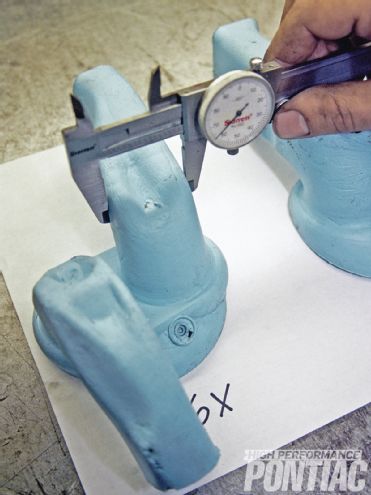 4 The best method to determine the actual port dimension is to measure it with a caliper.
4 The best method to determine the actual port dimension is to measure it with a caliper.
To produce any mold, you will need to simply fix the cylinder head in the appropriate position, apply the release agent in the ports, and block or plug any area where the molding compound can escape, such as the spark plug hole and valve guide. Then mix the product, pour it in, and let it cure. Next, extract the mold to complete the process.
Silicone rubber does not like to stick to things, so there will be little to no clean up of the port, but due to the intricate and often changing shape of a runner, it may be tricky to get out. Patience is a real virtue when it comes to extraction, along with a proper release agent applied to the surface before the rubber is poured.
Studying The Port
What you do and glean from a port mold depends on your ultimate goal. For example, if you are interested in porting the cylinder heads on your Pontiac engine, then you will study the mold for restrictions, sharp turns, pinch point, and so on. Once these flow obstacles are located, you can use a piece of mechanic’s wire or soft welding rod to measure on the mold to identify the area you want to modify in the port. Place the wire in the port. Once the region is identified, mark it in the runner with machinist’s blue dye or a similar product.
If you are trying to choose between multiple cylinder heads you have available for your Pontiac, then you can make a mold of the different choices and carefully study and compare each port, since it will now be in plain view.
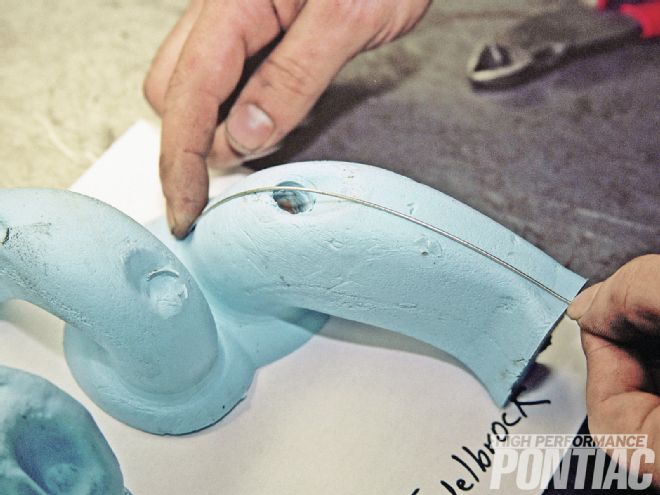 5 Use a piece of wire or welding rod to measure the top and bottom of the runner.
5 Use a piece of wire or welding rod to measure the top and bottom of the runner.
It is important to note that the customary method to determine runner size is a cc volume reading. Though this is a good indicator, it is not all-inclusive. Let me explain. You may find one cylinder head has a more efficient bowl area that is properly blended into the seat and a slightly smaller runner when measured with a caliper. This head may pour out in a cc test to a higher volume. Theoretically it will flow more air and have higher port velocity, since the volume is being increased in a region that promotes efficiency and speed. If one were to only reference a cc reading, then the head may be rejected as being too large for your engine combination.
Other aspects of the port can also be readily seen with a mold, such as the short-turn radius, the entry to the valve seat, intrusion of the pushrod into the flow area, and the impact of the valveguide.
The same logic can be applied to studying the runner of the intake manifold. An easy-to-make mold will reveal the true port shape and critical runner length that can be added to the intake runner length of the cylinder head. Total intake path length is of paramount concern when choosing a camshaft. The valve opening and closing events (“Project Pure Poncho,” June ’13) need to be able to capture any inertia that the charge has. (This is especially true with Third-Generation TPI engines, since the extremely long runner needs to open the valve during the second harmonic pulse to achieve the best performance.) When total runner length is known, the camshaft company can better select the proper grind for your Pontiac.
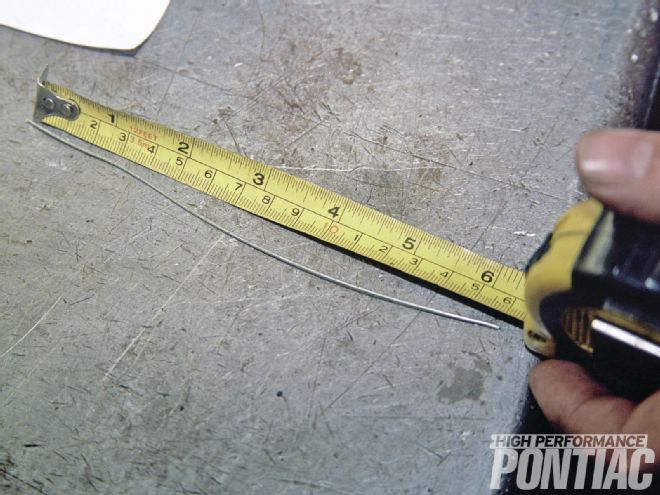 6 On the workbench, measure the two lengths (top and bottom of the runner), add the values, and then divide by two. This is the total runner length from the entry of the cylinder head to the seat of the valve.
6 On the workbench, measure the two lengths (top and bottom of the runner), add the values, and then divide by two. This is the total runner length from the entry of the cylinder head to the seat of the valve.
Making a mold of the cylinder head ports and, if applicable, the intake manifold is normal procedure for an advanced engine program, but for the most part it has been absent in the Pontiac community. That is, until now that HPP has let the cat—or should I say tiger?—out of the bag!
An easy-to-make mold will reveal the true port shape and critical runner length that can be added to the intake runner length of the cylinder head